Family Centered Nursing: Addressing Childhood Obesity in Australia
VerifiedAdded on 2023/06/14
|14
|4004
|215
AI Summary
This essay discusses family centered nursing and its role in addressing childhood obesity in Australia. It covers the seriousness of childhood obesity, government strategies to reduce it, and the role of nurses in making these strategies successful.
Contribute Materials
Your contribution can guide someone’s learning journey. Share your
documents today.
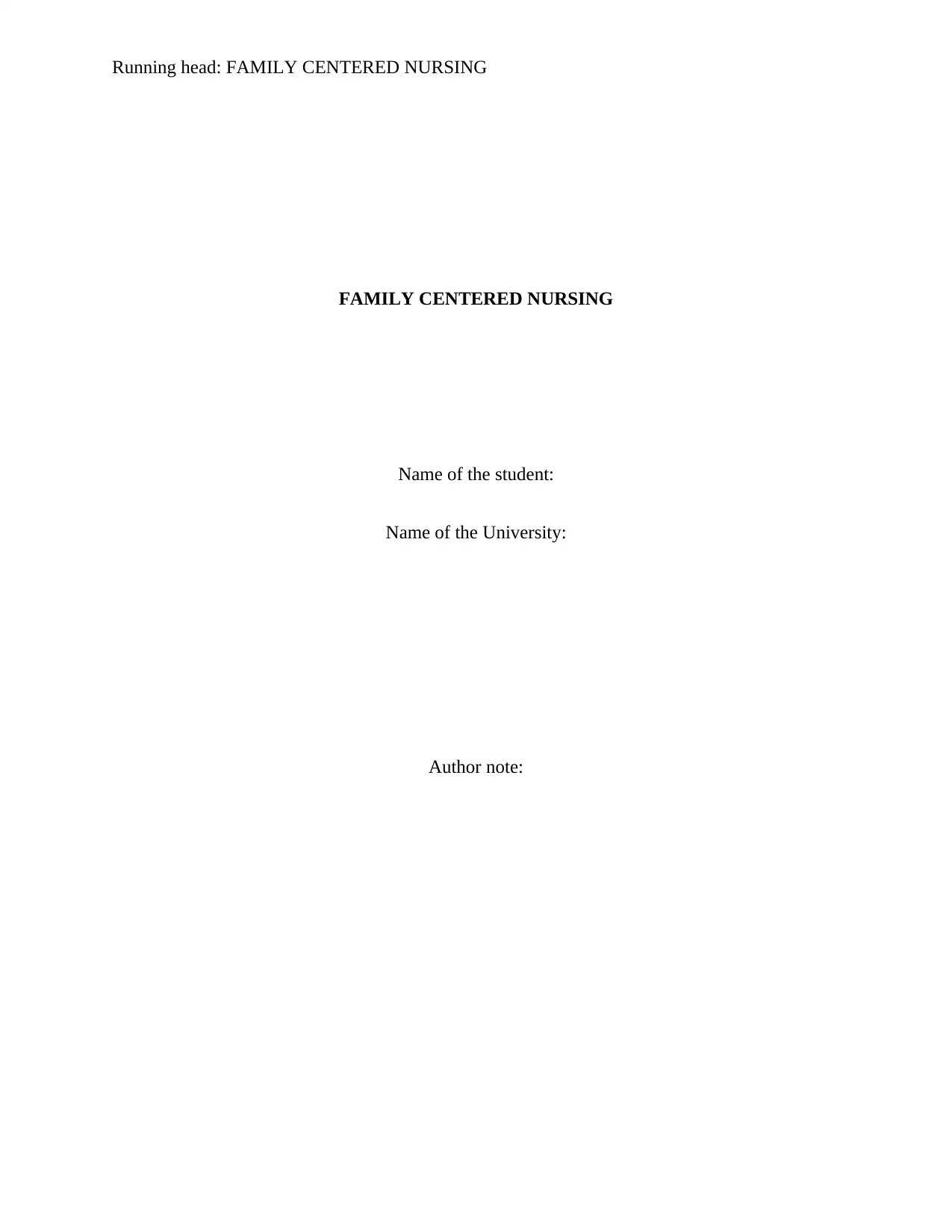
Running head: FAMILY CENTERED NURSING
FAMILY CENTERED NURSING
Name of the student:
Name of the University:
Author note:
FAMILY CENTERED NURSING
Name of the student:
Name of the University:
Author note:
Secure Best Marks with AI Grader
Need help grading? Try our AI Grader for instant feedback on your assignments.
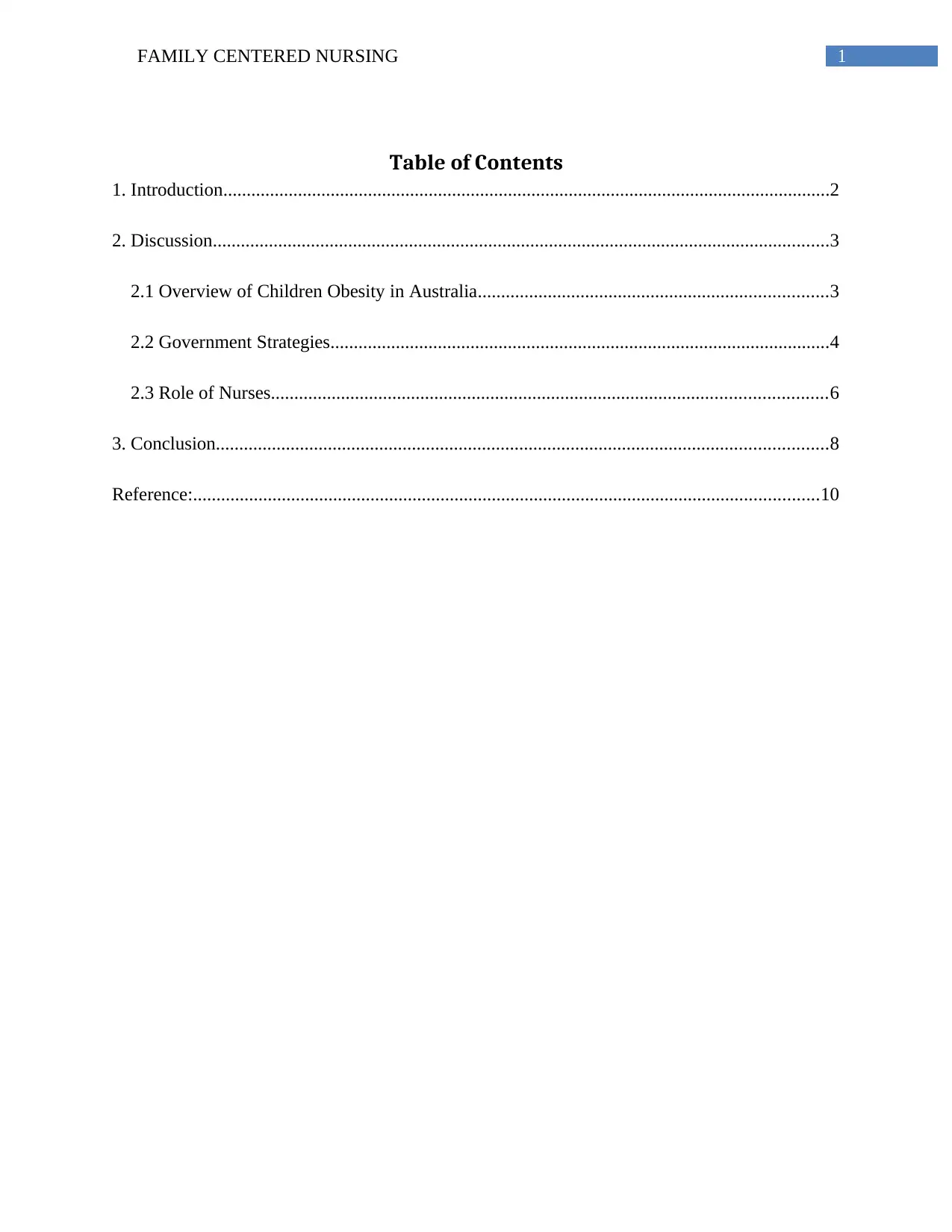
1FAMILY CENTERED NURSING
Table of Contents
1. Introduction..................................................................................................................................2
2. Discussion....................................................................................................................................3
2.1 Overview of Children Obesity in Australia...........................................................................3
2.2 Government Strategies...........................................................................................................4
2.3 Role of Nurses.......................................................................................................................6
3. Conclusion...................................................................................................................................8
Reference:......................................................................................................................................10
Table of Contents
1. Introduction..................................................................................................................................2
2. Discussion....................................................................................................................................3
2.1 Overview of Children Obesity in Australia...........................................................................3
2.2 Government Strategies...........................................................................................................4
2.3 Role of Nurses.......................................................................................................................6
3. Conclusion...................................................................................................................................8
Reference:......................................................................................................................................10
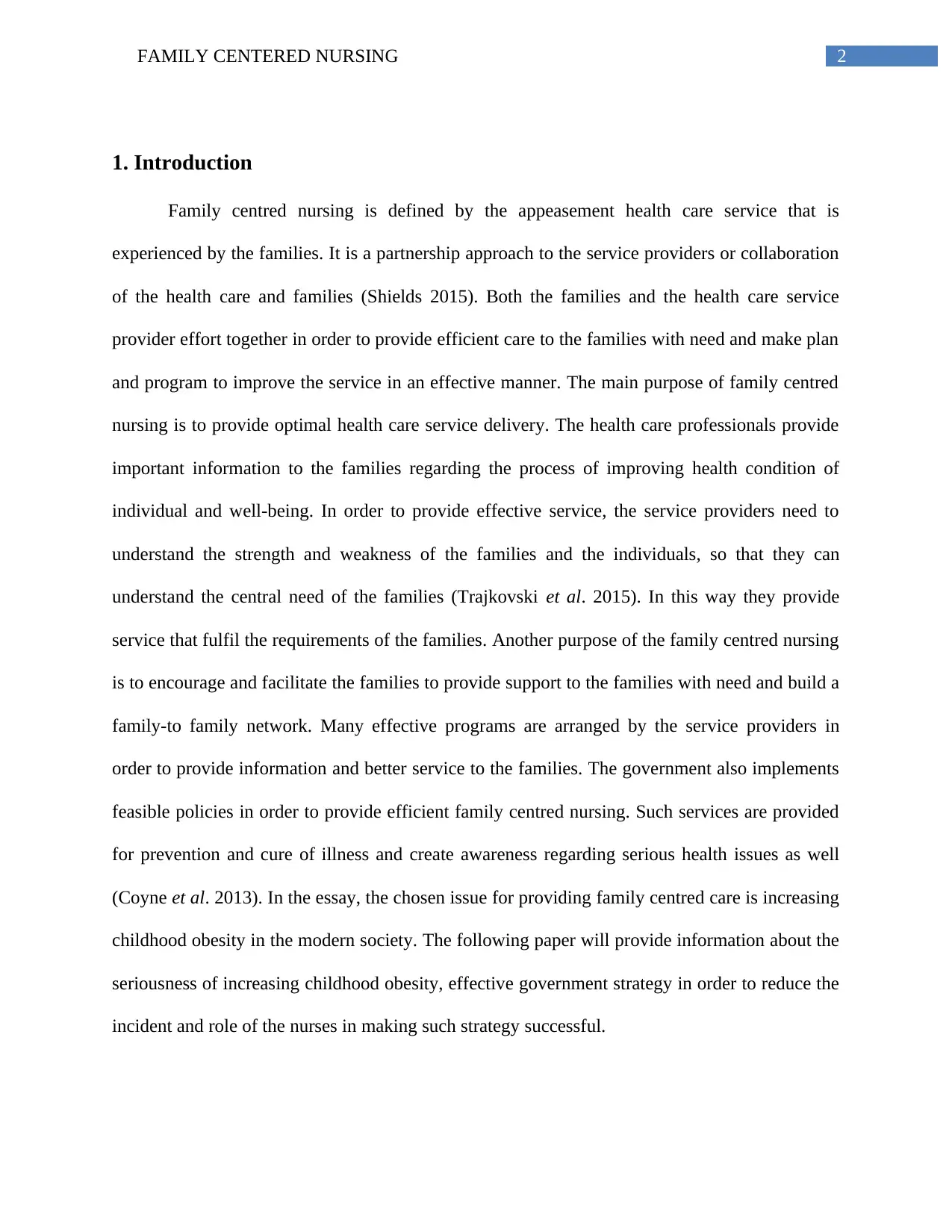
2FAMILY CENTERED NURSING
1. Introduction
Family centred nursing is defined by the appeasement health care service that is
experienced by the families. It is a partnership approach to the service providers or collaboration
of the health care and families (Shields 2015). Both the families and the health care service
provider effort together in order to provide efficient care to the families with need and make plan
and program to improve the service in an effective manner. The main purpose of family centred
nursing is to provide optimal health care service delivery. The health care professionals provide
important information to the families regarding the process of improving health condition of
individual and well-being. In order to provide effective service, the service providers need to
understand the strength and weakness of the families and the individuals, so that they can
understand the central need of the families (Trajkovski et al. 2015). In this way they provide
service that fulfil the requirements of the families. Another purpose of the family centred nursing
is to encourage and facilitate the families to provide support to the families with need and build a
family-to family network. Many effective programs are arranged by the service providers in
order to provide information and better service to the families. The government also implements
feasible policies in order to provide efficient family centred nursing. Such services are provided
for prevention and cure of illness and create awareness regarding serious health issues as well
(Coyne et al. 2013). In the essay, the chosen issue for providing family centred care is increasing
childhood obesity in the modern society. The following paper will provide information about the
seriousness of increasing childhood obesity, effective government strategy in order to reduce the
incident and role of the nurses in making such strategy successful.
1. Introduction
Family centred nursing is defined by the appeasement health care service that is
experienced by the families. It is a partnership approach to the service providers or collaboration
of the health care and families (Shields 2015). Both the families and the health care service
provider effort together in order to provide efficient care to the families with need and make plan
and program to improve the service in an effective manner. The main purpose of family centred
nursing is to provide optimal health care service delivery. The health care professionals provide
important information to the families regarding the process of improving health condition of
individual and well-being. In order to provide effective service, the service providers need to
understand the strength and weakness of the families and the individuals, so that they can
understand the central need of the families (Trajkovski et al. 2015). In this way they provide
service that fulfil the requirements of the families. Another purpose of the family centred nursing
is to encourage and facilitate the families to provide support to the families with need and build a
family-to family network. Many effective programs are arranged by the service providers in
order to provide information and better service to the families. The government also implements
feasible policies in order to provide efficient family centred nursing. Such services are provided
for prevention and cure of illness and create awareness regarding serious health issues as well
(Coyne et al. 2013). In the essay, the chosen issue for providing family centred care is increasing
childhood obesity in the modern society. The following paper will provide information about the
seriousness of increasing childhood obesity, effective government strategy in order to reduce the
incident and role of the nurses in making such strategy successful.
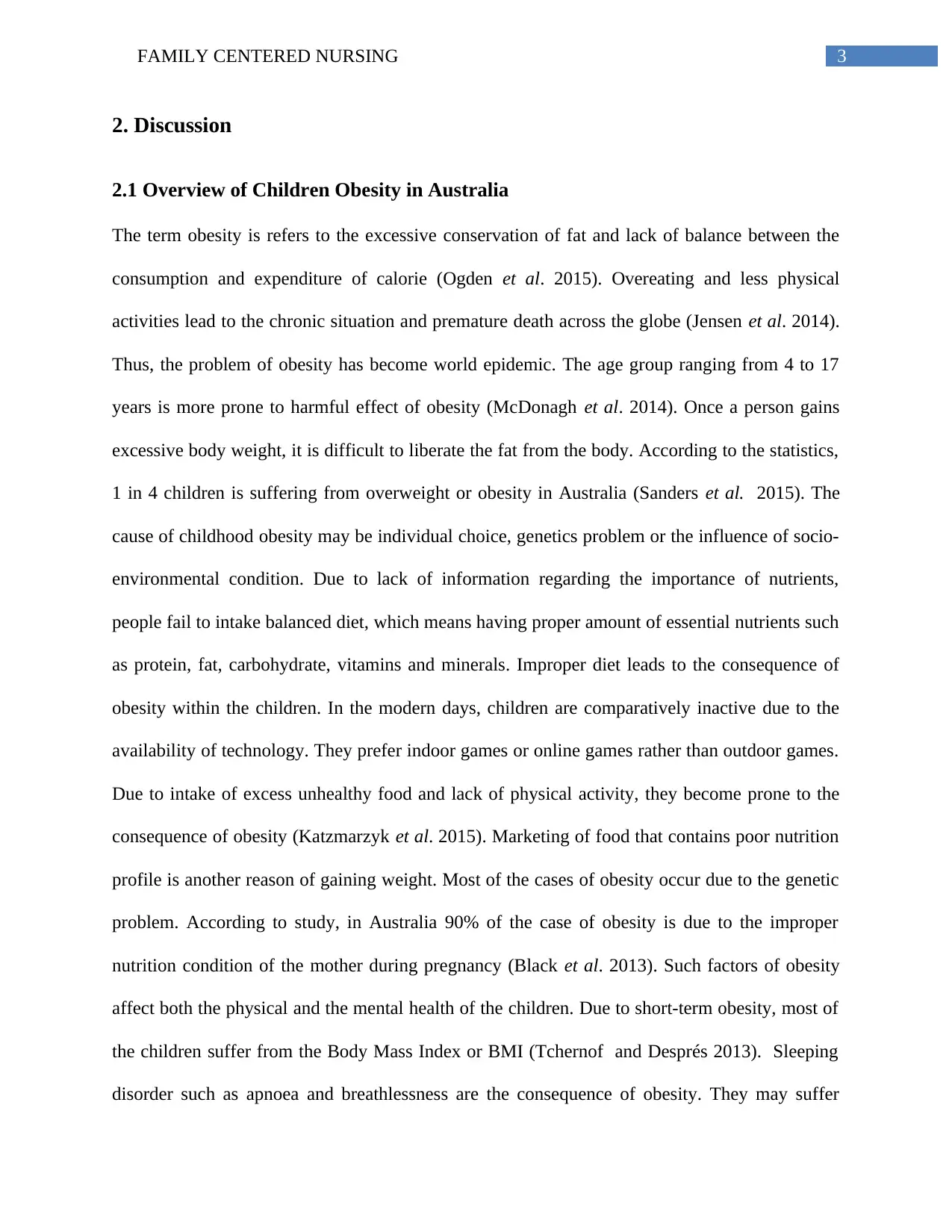
3FAMILY CENTERED NURSING
2. Discussion
2.1 Overview of Children Obesity in Australia
The term obesity is refers to the excessive conservation of fat and lack of balance between the
consumption and expenditure of calorie (Ogden et al. 2015). Overeating and less physical
activities lead to the chronic situation and premature death across the globe (Jensen et al. 2014).
Thus, the problem of obesity has become world epidemic. The age group ranging from 4 to 17
years is more prone to harmful effect of obesity (McDonagh et al. 2014). Once a person gains
excessive body weight, it is difficult to liberate the fat from the body. According to the statistics,
1 in 4 children is suffering from overweight or obesity in Australia (Sanders et al. 2015). The
cause of childhood obesity may be individual choice, genetics problem or the influence of socio-
environmental condition. Due to lack of information regarding the importance of nutrients,
people fail to intake balanced diet, which means having proper amount of essential nutrients such
as protein, fat, carbohydrate, vitamins and minerals. Improper diet leads to the consequence of
obesity within the children. In the modern days, children are comparatively inactive due to the
availability of technology. They prefer indoor games or online games rather than outdoor games.
Due to intake of excess unhealthy food and lack of physical activity, they become prone to the
consequence of obesity (Katzmarzyk et al. 2015). Marketing of food that contains poor nutrition
profile is another reason of gaining weight. Most of the cases of obesity occur due to the genetic
problem. According to study, in Australia 90% of the case of obesity is due to the improper
nutrition condition of the mother during pregnancy (Black et al. 2013). Such factors of obesity
affect both the physical and the mental health of the children. Due to short-term obesity, most of
the children suffer from the Body Mass Index or BMI (Tchernof and Després 2013). Sleeping
disorder such as apnoea and breathlessness are the consequence of obesity. They may suffer
2. Discussion
2.1 Overview of Children Obesity in Australia
The term obesity is refers to the excessive conservation of fat and lack of balance between the
consumption and expenditure of calorie (Ogden et al. 2015). Overeating and less physical
activities lead to the chronic situation and premature death across the globe (Jensen et al. 2014).
Thus, the problem of obesity has become world epidemic. The age group ranging from 4 to 17
years is more prone to harmful effect of obesity (McDonagh et al. 2014). Once a person gains
excessive body weight, it is difficult to liberate the fat from the body. According to the statistics,
1 in 4 children is suffering from overweight or obesity in Australia (Sanders et al. 2015). The
cause of childhood obesity may be individual choice, genetics problem or the influence of socio-
environmental condition. Due to lack of information regarding the importance of nutrients,
people fail to intake balanced diet, which means having proper amount of essential nutrients such
as protein, fat, carbohydrate, vitamins and minerals. Improper diet leads to the consequence of
obesity within the children. In the modern days, children are comparatively inactive due to the
availability of technology. They prefer indoor games or online games rather than outdoor games.
Due to intake of excess unhealthy food and lack of physical activity, they become prone to the
consequence of obesity (Katzmarzyk et al. 2015). Marketing of food that contains poor nutrition
profile is another reason of gaining weight. Most of the cases of obesity occur due to the genetic
problem. According to study, in Australia 90% of the case of obesity is due to the improper
nutrition condition of the mother during pregnancy (Black et al. 2013). Such factors of obesity
affect both the physical and the mental health of the children. Due to short-term obesity, most of
the children suffer from the Body Mass Index or BMI (Tchernof and Després 2013). Sleeping
disorder such as apnoea and breathlessness are the consequence of obesity. They may suffer
Secure Best Marks with AI Grader
Need help grading? Try our AI Grader for instant feedback on your assignments.
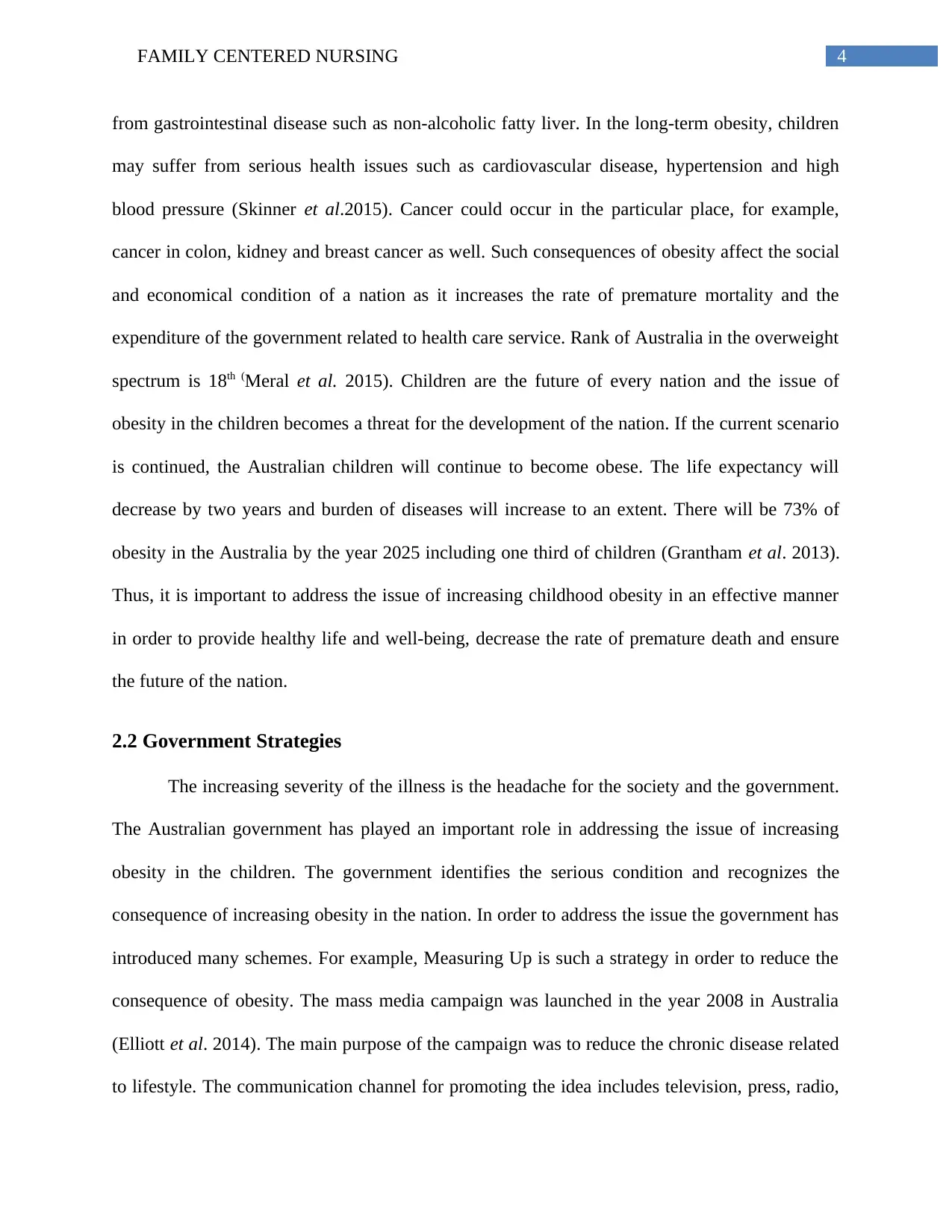
4FAMILY CENTERED NURSING
from gastrointestinal disease such as non-alcoholic fatty liver. In the long-term obesity, children
may suffer from serious health issues such as cardiovascular disease, hypertension and high
blood pressure (Skinner et al.2015). Cancer could occur in the particular place, for example,
cancer in colon, kidney and breast cancer as well. Such consequences of obesity affect the social
and economical condition of a nation as it increases the rate of premature mortality and the
expenditure of the government related to health care service. Rank of Australia in the overweight
spectrum is 18th (Meral et al. 2015). Children are the future of every nation and the issue of
obesity in the children becomes a threat for the development of the nation. If the current scenario
is continued, the Australian children will continue to become obese. The life expectancy will
decrease by two years and burden of diseases will increase to an extent. There will be 73% of
obesity in the Australia by the year 2025 including one third of children (Grantham et al. 2013).
Thus, it is important to address the issue of increasing childhood obesity in an effective manner
in order to provide healthy life and well-being, decrease the rate of premature death and ensure
the future of the nation.
2.2 Government Strategies
The increasing severity of the illness is the headache for the society and the government.
The Australian government has played an important role in addressing the issue of increasing
obesity in the children. The government identifies the serious condition and recognizes the
consequence of increasing obesity in the nation. In order to address the issue the government has
introduced many schemes. For example, Measuring Up is such a strategy in order to reduce the
consequence of obesity. The mass media campaign was launched in the year 2008 in Australia
(Elliott et al. 2014). The main purpose of the campaign was to reduce the chronic disease related
to lifestyle. The communication channel for promoting the idea includes television, press, radio,
from gastrointestinal disease such as non-alcoholic fatty liver. In the long-term obesity, children
may suffer from serious health issues such as cardiovascular disease, hypertension and high
blood pressure (Skinner et al.2015). Cancer could occur in the particular place, for example,
cancer in colon, kidney and breast cancer as well. Such consequences of obesity affect the social
and economical condition of a nation as it increases the rate of premature mortality and the
expenditure of the government related to health care service. Rank of Australia in the overweight
spectrum is 18th (Meral et al. 2015). Children are the future of every nation and the issue of
obesity in the children becomes a threat for the development of the nation. If the current scenario
is continued, the Australian children will continue to become obese. The life expectancy will
decrease by two years and burden of diseases will increase to an extent. There will be 73% of
obesity in the Australia by the year 2025 including one third of children (Grantham et al. 2013).
Thus, it is important to address the issue of increasing childhood obesity in an effective manner
in order to provide healthy life and well-being, decrease the rate of premature death and ensure
the future of the nation.
2.2 Government Strategies
The increasing severity of the illness is the headache for the society and the government.
The Australian government has played an important role in addressing the issue of increasing
obesity in the children. The government identifies the serious condition and recognizes the
consequence of increasing obesity in the nation. In order to address the issue the government has
introduced many schemes. For example, Measuring Up is such a strategy in order to reduce the
consequence of obesity. The mass media campaign was launched in the year 2008 in Australia
(Elliott et al. 2014). The main purpose of the campaign was to reduce the chronic disease related
to lifestyle. The communication channel for promoting the idea includes television, press, radio,
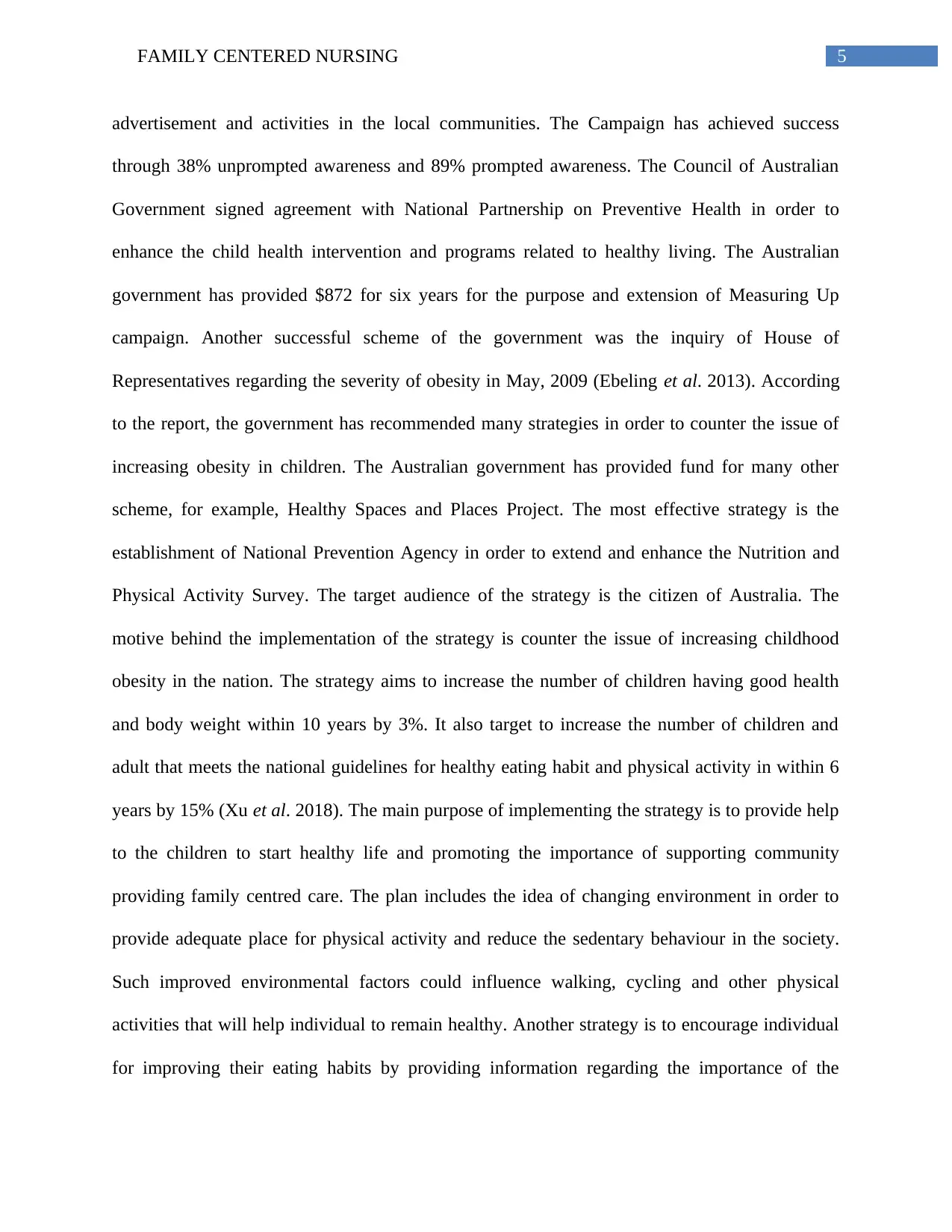
5FAMILY CENTERED NURSING
advertisement and activities in the local communities. The Campaign has achieved success
through 38% unprompted awareness and 89% prompted awareness. The Council of Australian
Government signed agreement with National Partnership on Preventive Health in order to
enhance the child health intervention and programs related to healthy living. The Australian
government has provided $872 for six years for the purpose and extension of Measuring Up
campaign. Another successful scheme of the government was the inquiry of House of
Representatives regarding the severity of obesity in May, 2009 (Ebeling et al. 2013). According
to the report, the government has recommended many strategies in order to counter the issue of
increasing obesity in children. The Australian government has provided fund for many other
scheme, for example, Healthy Spaces and Places Project. The most effective strategy is the
establishment of National Prevention Agency in order to extend and enhance the Nutrition and
Physical Activity Survey. The target audience of the strategy is the citizen of Australia. The
motive behind the implementation of the strategy is counter the issue of increasing childhood
obesity in the nation. The strategy aims to increase the number of children having good health
and body weight within 10 years by 3%. It also target to increase the number of children and
adult that meets the national guidelines for healthy eating habit and physical activity in within 6
years by 15% (Xu et al. 2018). The main purpose of implementing the strategy is to provide help
to the children to start healthy life and promoting the importance of supporting community
providing family centred care. The plan includes the idea of changing environment in order to
provide adequate place for physical activity and reduce the sedentary behaviour in the society.
Such improved environmental factors could influence walking, cycling and other physical
activities that will help individual to remain healthy. Another strategy is to encourage individual
for improving their eating habits by providing information regarding the importance of the
advertisement and activities in the local communities. The Campaign has achieved success
through 38% unprompted awareness and 89% prompted awareness. The Council of Australian
Government signed agreement with National Partnership on Preventive Health in order to
enhance the child health intervention and programs related to healthy living. The Australian
government has provided $872 for six years for the purpose and extension of Measuring Up
campaign. Another successful scheme of the government was the inquiry of House of
Representatives regarding the severity of obesity in May, 2009 (Ebeling et al. 2013). According
to the report, the government has recommended many strategies in order to counter the issue of
increasing obesity in children. The Australian government has provided fund for many other
scheme, for example, Healthy Spaces and Places Project. The most effective strategy is the
establishment of National Prevention Agency in order to extend and enhance the Nutrition and
Physical Activity Survey. The target audience of the strategy is the citizen of Australia. The
motive behind the implementation of the strategy is counter the issue of increasing childhood
obesity in the nation. The strategy aims to increase the number of children having good health
and body weight within 10 years by 3%. It also target to increase the number of children and
adult that meets the national guidelines for healthy eating habit and physical activity in within 6
years by 15% (Xu et al. 2018). The main purpose of implementing the strategy is to provide help
to the children to start healthy life and promoting the importance of supporting community
providing family centred care. The plan includes the idea of changing environment in order to
provide adequate place for physical activity and reduce the sedentary behaviour in the society.
Such improved environmental factors could influence walking, cycling and other physical
activities that will help individual to remain healthy. Another strategy is to encourage individual
for improving their eating habits by providing information regarding the importance of the
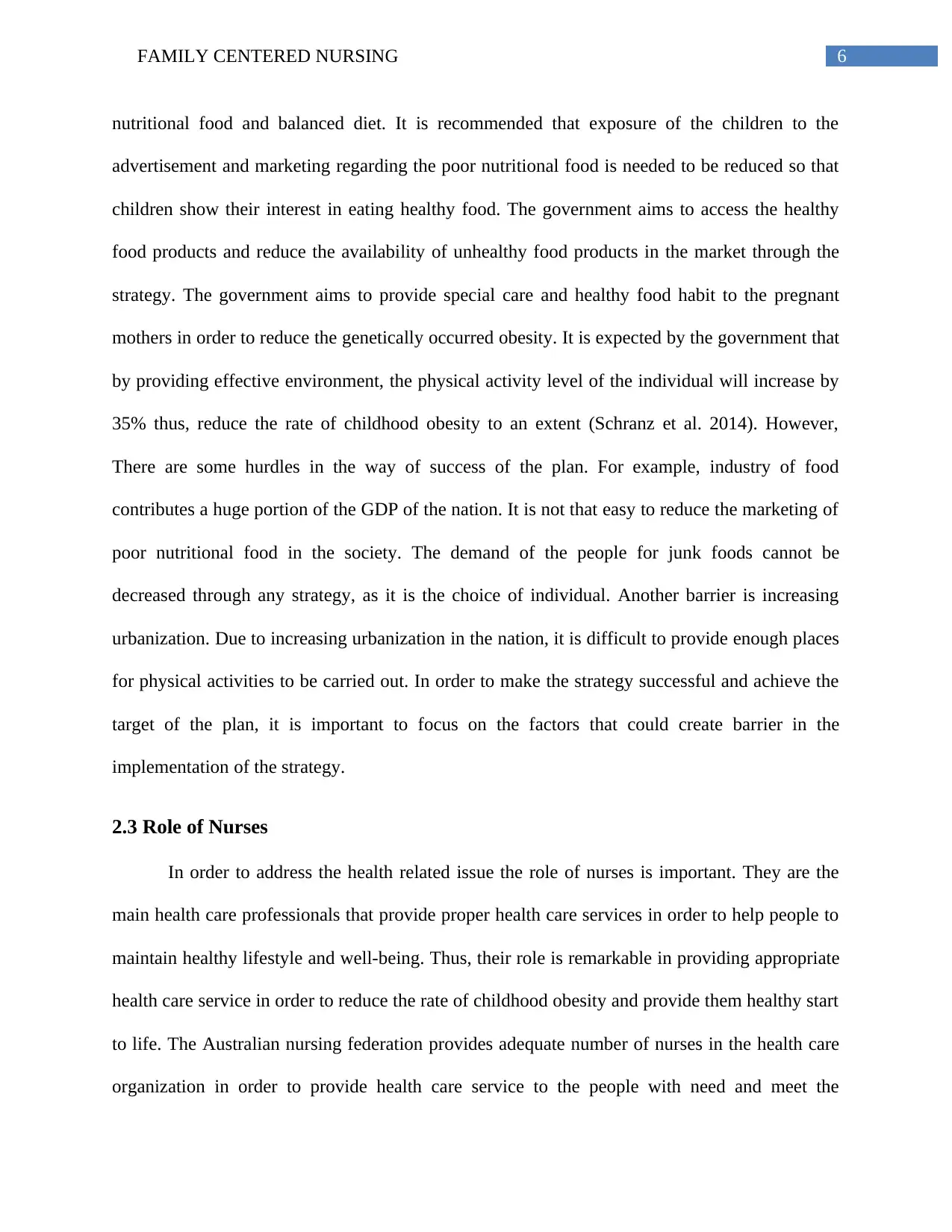
6FAMILY CENTERED NURSING
nutritional food and balanced diet. It is recommended that exposure of the children to the
advertisement and marketing regarding the poor nutritional food is needed to be reduced so that
children show their interest in eating healthy food. The government aims to access the healthy
food products and reduce the availability of unhealthy food products in the market through the
strategy. The government aims to provide special care and healthy food habit to the pregnant
mothers in order to reduce the genetically occurred obesity. It is expected by the government that
by providing effective environment, the physical activity level of the individual will increase by
35% thus, reduce the rate of childhood obesity to an extent (Schranz et al. 2014). However,
There are some hurdles in the way of success of the plan. For example, industry of food
contributes a huge portion of the GDP of the nation. It is not that easy to reduce the marketing of
poor nutritional food in the society. The demand of the people for junk foods cannot be
decreased through any strategy, as it is the choice of individual. Another barrier is increasing
urbanization. Due to increasing urbanization in the nation, it is difficult to provide enough places
for physical activities to be carried out. In order to make the strategy successful and achieve the
target of the plan, it is important to focus on the factors that could create barrier in the
implementation of the strategy.
2.3 Role of Nurses
In order to address the health related issue the role of nurses is important. They are the
main health care professionals that provide proper health care services in order to help people to
maintain healthy lifestyle and well-being. Thus, their role is remarkable in providing appropriate
health care service in order to reduce the rate of childhood obesity and provide them healthy start
to life. The Australian nursing federation provides adequate number of nurses in the health care
organization in order to provide health care service to the people with need and meet the
nutritional food and balanced diet. It is recommended that exposure of the children to the
advertisement and marketing regarding the poor nutritional food is needed to be reduced so that
children show their interest in eating healthy food. The government aims to access the healthy
food products and reduce the availability of unhealthy food products in the market through the
strategy. The government aims to provide special care and healthy food habit to the pregnant
mothers in order to reduce the genetically occurred obesity. It is expected by the government that
by providing effective environment, the physical activity level of the individual will increase by
35% thus, reduce the rate of childhood obesity to an extent (Schranz et al. 2014). However,
There are some hurdles in the way of success of the plan. For example, industry of food
contributes a huge portion of the GDP of the nation. It is not that easy to reduce the marketing of
poor nutritional food in the society. The demand of the people for junk foods cannot be
decreased through any strategy, as it is the choice of individual. Another barrier is increasing
urbanization. Due to increasing urbanization in the nation, it is difficult to provide enough places
for physical activities to be carried out. In order to make the strategy successful and achieve the
target of the plan, it is important to focus on the factors that could create barrier in the
implementation of the strategy.
2.3 Role of Nurses
In order to address the health related issue the role of nurses is important. They are the
main health care professionals that provide proper health care services in order to help people to
maintain healthy lifestyle and well-being. Thus, their role is remarkable in providing appropriate
health care service in order to reduce the rate of childhood obesity and provide them healthy start
to life. The Australian nursing federation provides adequate number of nurses in the health care
organization in order to provide health care service to the people with need and meet the
Paraphrase This Document
Need a fresh take? Get an instant paraphrase of this document with our AI Paraphraser
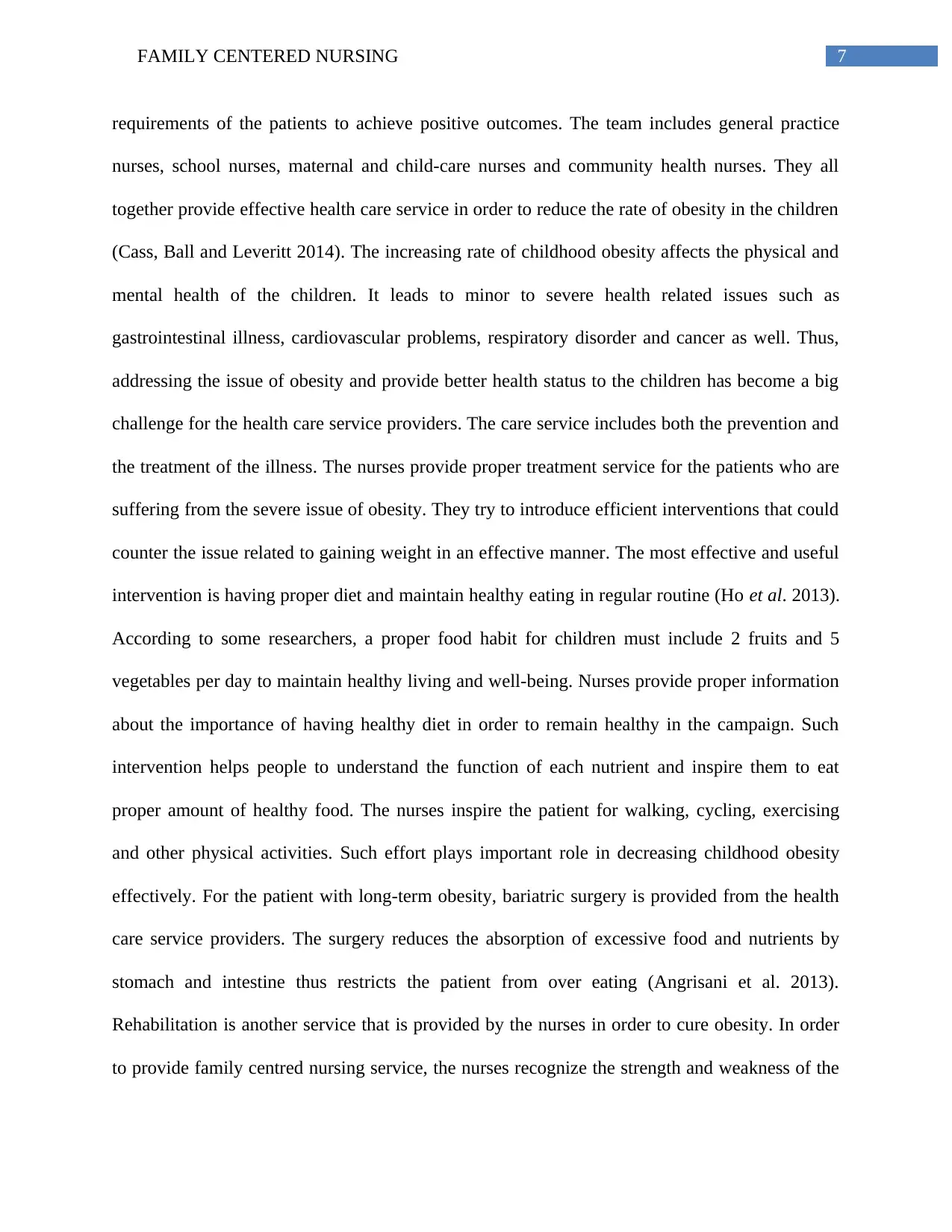
7FAMILY CENTERED NURSING
requirements of the patients to achieve positive outcomes. The team includes general practice
nurses, school nurses, maternal and child-care nurses and community health nurses. They all
together provide effective health care service in order to reduce the rate of obesity in the children
(Cass, Ball and Leveritt 2014). The increasing rate of childhood obesity affects the physical and
mental health of the children. It leads to minor to severe health related issues such as
gastrointestinal illness, cardiovascular problems, respiratory disorder and cancer as well. Thus,
addressing the issue of obesity and provide better health status to the children has become a big
challenge for the health care service providers. The care service includes both the prevention and
the treatment of the illness. The nurses provide proper treatment service for the patients who are
suffering from the severe issue of obesity. They try to introduce efficient interventions that could
counter the issue related to gaining weight in an effective manner. The most effective and useful
intervention is having proper diet and maintain healthy eating in regular routine (Ho et al. 2013).
According to some researchers, a proper food habit for children must include 2 fruits and 5
vegetables per day to maintain healthy living and well-being. Nurses provide proper information
about the importance of having healthy diet in order to remain healthy in the campaign. Such
intervention helps people to understand the function of each nutrient and inspire them to eat
proper amount of healthy food. The nurses inspire the patient for walking, cycling, exercising
and other physical activities. Such effort plays important role in decreasing childhood obesity
effectively. For the patient with long-term obesity, bariatric surgery is provided from the health
care service providers. The surgery reduces the absorption of excessive food and nutrients by
stomach and intestine thus restricts the patient from over eating (Angrisani et al. 2013).
Rehabilitation is another service that is provided by the nurses in order to cure obesity. In order
to provide family centred nursing service, the nurses recognize the strength and weakness of the
requirements of the patients to achieve positive outcomes. The team includes general practice
nurses, school nurses, maternal and child-care nurses and community health nurses. They all
together provide effective health care service in order to reduce the rate of obesity in the children
(Cass, Ball and Leveritt 2014). The increasing rate of childhood obesity affects the physical and
mental health of the children. It leads to minor to severe health related issues such as
gastrointestinal illness, cardiovascular problems, respiratory disorder and cancer as well. Thus,
addressing the issue of obesity and provide better health status to the children has become a big
challenge for the health care service providers. The care service includes both the prevention and
the treatment of the illness. The nurses provide proper treatment service for the patients who are
suffering from the severe issue of obesity. They try to introduce efficient interventions that could
counter the issue related to gaining weight in an effective manner. The most effective and useful
intervention is having proper diet and maintain healthy eating in regular routine (Ho et al. 2013).
According to some researchers, a proper food habit for children must include 2 fruits and 5
vegetables per day to maintain healthy living and well-being. Nurses provide proper information
about the importance of having healthy diet in order to remain healthy in the campaign. Such
intervention helps people to understand the function of each nutrient and inspire them to eat
proper amount of healthy food. The nurses inspire the patient for walking, cycling, exercising
and other physical activities. Such effort plays important role in decreasing childhood obesity
effectively. For the patient with long-term obesity, bariatric surgery is provided from the health
care service providers. The surgery reduces the absorption of excessive food and nutrients by
stomach and intestine thus restricts the patient from over eating (Angrisani et al. 2013).
Rehabilitation is another service that is provided by the nurses in order to cure obesity. In order
to provide family centred nursing service, the nurses recognize the strength and weakness of the
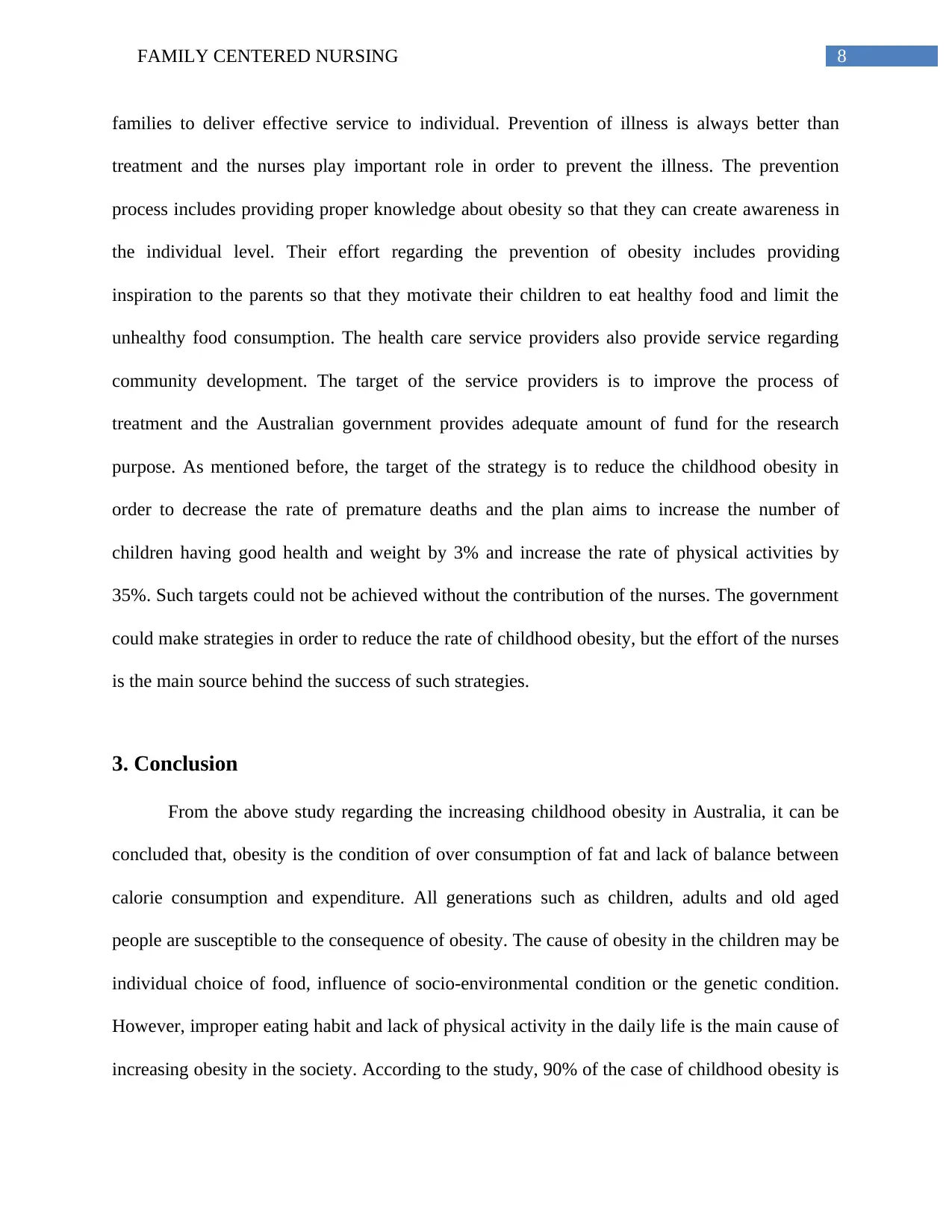
8FAMILY CENTERED NURSING
families to deliver effective service to individual. Prevention of illness is always better than
treatment and the nurses play important role in order to prevent the illness. The prevention
process includes providing proper knowledge about obesity so that they can create awareness in
the individual level. Their effort regarding the prevention of obesity includes providing
inspiration to the parents so that they motivate their children to eat healthy food and limit the
unhealthy food consumption. The health care service providers also provide service regarding
community development. The target of the service providers is to improve the process of
treatment and the Australian government provides adequate amount of fund for the research
purpose. As mentioned before, the target of the strategy is to reduce the childhood obesity in
order to decrease the rate of premature deaths and the plan aims to increase the number of
children having good health and weight by 3% and increase the rate of physical activities by
35%. Such targets could not be achieved without the contribution of the nurses. The government
could make strategies in order to reduce the rate of childhood obesity, but the effort of the nurses
is the main source behind the success of such strategies.
3. Conclusion
From the above study regarding the increasing childhood obesity in Australia, it can be
concluded that, obesity is the condition of over consumption of fat and lack of balance between
calorie consumption and expenditure. All generations such as children, adults and old aged
people are susceptible to the consequence of obesity. The cause of obesity in the children may be
individual choice of food, influence of socio-environmental condition or the genetic condition.
However, improper eating habit and lack of physical activity in the daily life is the main cause of
increasing obesity in the society. According to the study, 90% of the case of childhood obesity is
families to deliver effective service to individual. Prevention of illness is always better than
treatment and the nurses play important role in order to prevent the illness. The prevention
process includes providing proper knowledge about obesity so that they can create awareness in
the individual level. Their effort regarding the prevention of obesity includes providing
inspiration to the parents so that they motivate their children to eat healthy food and limit the
unhealthy food consumption. The health care service providers also provide service regarding
community development. The target of the service providers is to improve the process of
treatment and the Australian government provides adequate amount of fund for the research
purpose. As mentioned before, the target of the strategy is to reduce the childhood obesity in
order to decrease the rate of premature deaths and the plan aims to increase the number of
children having good health and weight by 3% and increase the rate of physical activities by
35%. Such targets could not be achieved without the contribution of the nurses. The government
could make strategies in order to reduce the rate of childhood obesity, but the effort of the nurses
is the main source behind the success of such strategies.
3. Conclusion
From the above study regarding the increasing childhood obesity in Australia, it can be
concluded that, obesity is the condition of over consumption of fat and lack of balance between
calorie consumption and expenditure. All generations such as children, adults and old aged
people are susceptible to the consequence of obesity. The cause of obesity in the children may be
individual choice of food, influence of socio-environmental condition or the genetic condition.
However, improper eating habit and lack of physical activity in the daily life is the main cause of
increasing obesity in the society. According to the study, 90% of the case of childhood obesity is
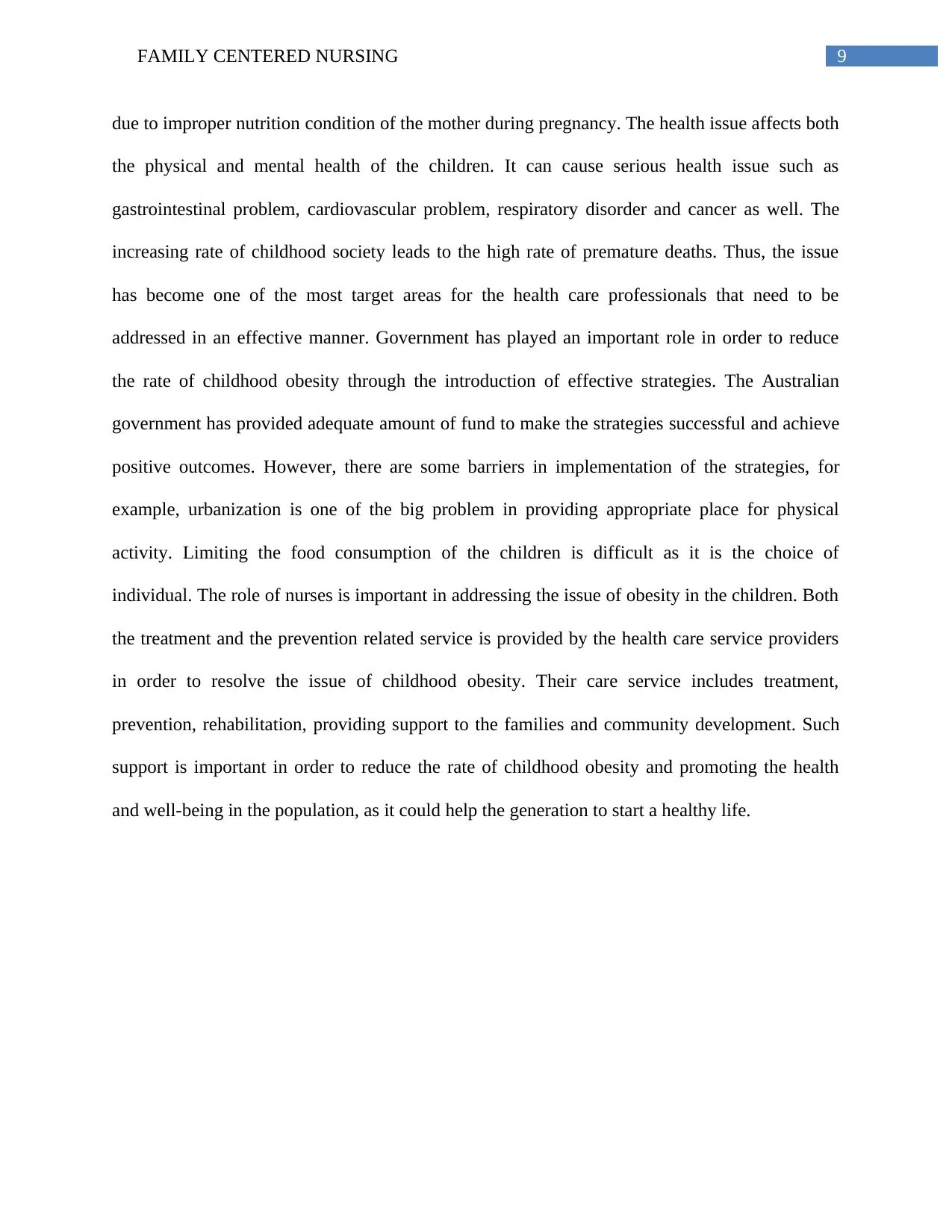
9FAMILY CENTERED NURSING
due to improper nutrition condition of the mother during pregnancy. The health issue affects both
the physical and mental health of the children. It can cause serious health issue such as
gastrointestinal problem, cardiovascular problem, respiratory disorder and cancer as well. The
increasing rate of childhood society leads to the high rate of premature deaths. Thus, the issue
has become one of the most target areas for the health care professionals that need to be
addressed in an effective manner. Government has played an important role in order to reduce
the rate of childhood obesity through the introduction of effective strategies. The Australian
government has provided adequate amount of fund to make the strategies successful and achieve
positive outcomes. However, there are some barriers in implementation of the strategies, for
example, urbanization is one of the big problem in providing appropriate place for physical
activity. Limiting the food consumption of the children is difficult as it is the choice of
individual. The role of nurses is important in addressing the issue of obesity in the children. Both
the treatment and the prevention related service is provided by the health care service providers
in order to resolve the issue of childhood obesity. Their care service includes treatment,
prevention, rehabilitation, providing support to the families and community development. Such
support is important in order to reduce the rate of childhood obesity and promoting the health
and well-being in the population, as it could help the generation to start a healthy life.
due to improper nutrition condition of the mother during pregnancy. The health issue affects both
the physical and mental health of the children. It can cause serious health issue such as
gastrointestinal problem, cardiovascular problem, respiratory disorder and cancer as well. The
increasing rate of childhood society leads to the high rate of premature deaths. Thus, the issue
has become one of the most target areas for the health care professionals that need to be
addressed in an effective manner. Government has played an important role in order to reduce
the rate of childhood obesity through the introduction of effective strategies. The Australian
government has provided adequate amount of fund to make the strategies successful and achieve
positive outcomes. However, there are some barriers in implementation of the strategies, for
example, urbanization is one of the big problem in providing appropriate place for physical
activity. Limiting the food consumption of the children is difficult as it is the choice of
individual. The role of nurses is important in addressing the issue of obesity in the children. Both
the treatment and the prevention related service is provided by the health care service providers
in order to resolve the issue of childhood obesity. Their care service includes treatment,
prevention, rehabilitation, providing support to the families and community development. Such
support is important in order to reduce the rate of childhood obesity and promoting the health
and well-being in the population, as it could help the generation to start a healthy life.
Secure Best Marks with AI Grader
Need help grading? Try our AI Grader for instant feedback on your assignments.
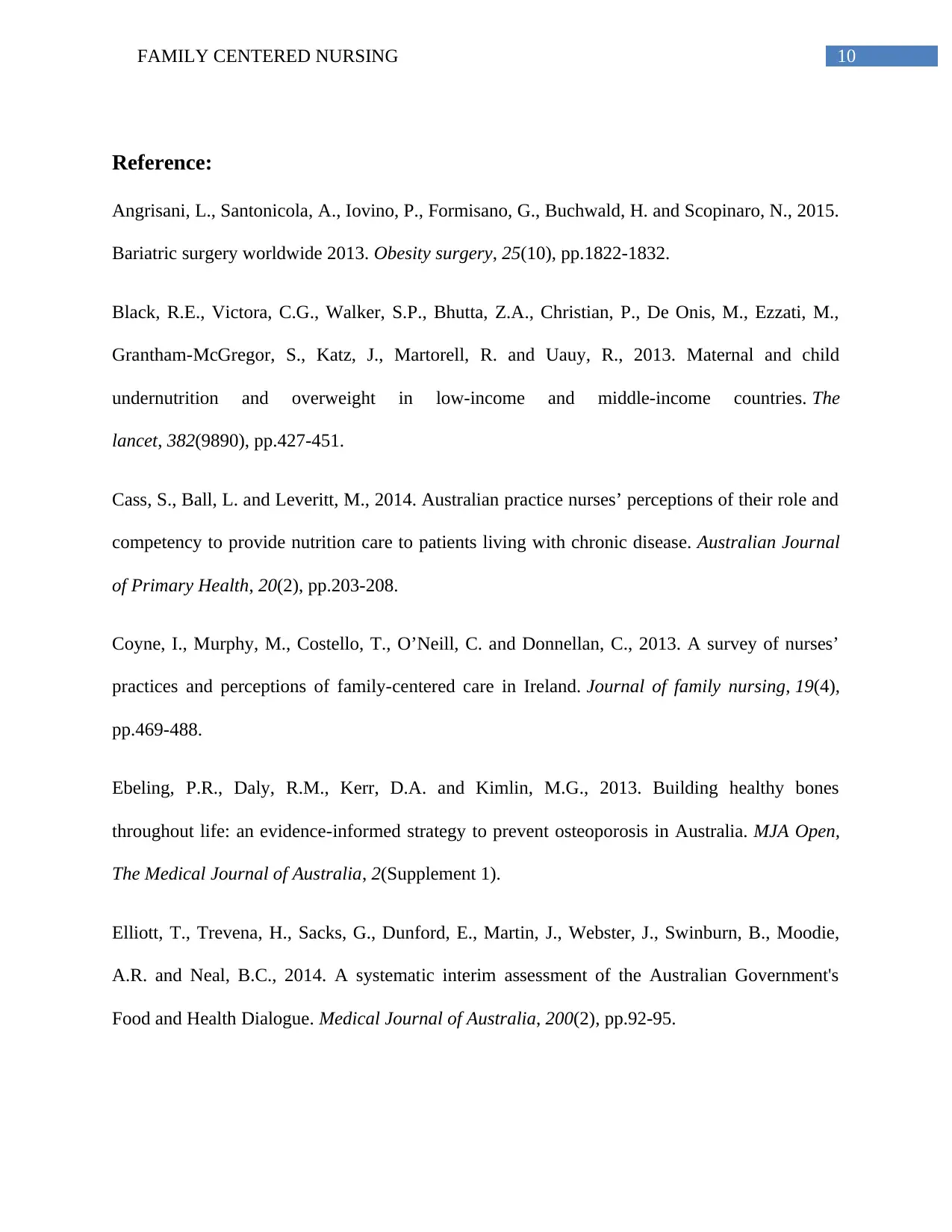
10FAMILY CENTERED NURSING
Reference:
Angrisani, L., Santonicola, A., Iovino, P., Formisano, G., Buchwald, H. and Scopinaro, N., 2015.
Bariatric surgery worldwide 2013. Obesity surgery, 25(10), pp.1822-1832.
Black, R.E., Victora, C.G., Walker, S.P., Bhutta, Z.A., Christian, P., De Onis, M., Ezzati, M.,
Grantham-McGregor, S., Katz, J., Martorell, R. and Uauy, R., 2013. Maternal and child
undernutrition and overweight in low-income and middle-income countries. The
lancet, 382(9890), pp.427-451.
Cass, S., Ball, L. and Leveritt, M., 2014. Australian practice nurses’ perceptions of their role and
competency to provide nutrition care to patients living with chronic disease. Australian Journal
of Primary Health, 20(2), pp.203-208.
Coyne, I., Murphy, M., Costello, T., O’Neill, C. and Donnellan, C., 2013. A survey of nurses’
practices and perceptions of family-centered care in Ireland. Journal of family nursing, 19(4),
pp.469-488.
Ebeling, P.R., Daly, R.M., Kerr, D.A. and Kimlin, M.G., 2013. Building healthy bones
throughout life: an evidence-informed strategy to prevent osteoporosis in Australia. MJA Open,
The Medical Journal of Australia, 2(Supplement 1).
Elliott, T., Trevena, H., Sacks, G., Dunford, E., Martin, J., Webster, J., Swinburn, B., Moodie,
A.R. and Neal, B.C., 2014. A systematic interim assessment of the Australian Government's
Food and Health Dialogue. Medical Journal of Australia, 200(2), pp.92-95.
Reference:
Angrisani, L., Santonicola, A., Iovino, P., Formisano, G., Buchwald, H. and Scopinaro, N., 2015.
Bariatric surgery worldwide 2013. Obesity surgery, 25(10), pp.1822-1832.
Black, R.E., Victora, C.G., Walker, S.P., Bhutta, Z.A., Christian, P., De Onis, M., Ezzati, M.,
Grantham-McGregor, S., Katz, J., Martorell, R. and Uauy, R., 2013. Maternal and child
undernutrition and overweight in low-income and middle-income countries. The
lancet, 382(9890), pp.427-451.
Cass, S., Ball, L. and Leveritt, M., 2014. Australian practice nurses’ perceptions of their role and
competency to provide nutrition care to patients living with chronic disease. Australian Journal
of Primary Health, 20(2), pp.203-208.
Coyne, I., Murphy, M., Costello, T., O’Neill, C. and Donnellan, C., 2013. A survey of nurses’
practices and perceptions of family-centered care in Ireland. Journal of family nursing, 19(4),
pp.469-488.
Ebeling, P.R., Daly, R.M., Kerr, D.A. and Kimlin, M.G., 2013. Building healthy bones
throughout life: an evidence-informed strategy to prevent osteoporosis in Australia. MJA Open,
The Medical Journal of Australia, 2(Supplement 1).
Elliott, T., Trevena, H., Sacks, G., Dunford, E., Martin, J., Webster, J., Swinburn, B., Moodie,
A.R. and Neal, B.C., 2014. A systematic interim assessment of the Australian Government's
Food and Health Dialogue. Medical Journal of Australia, 200(2), pp.92-95.
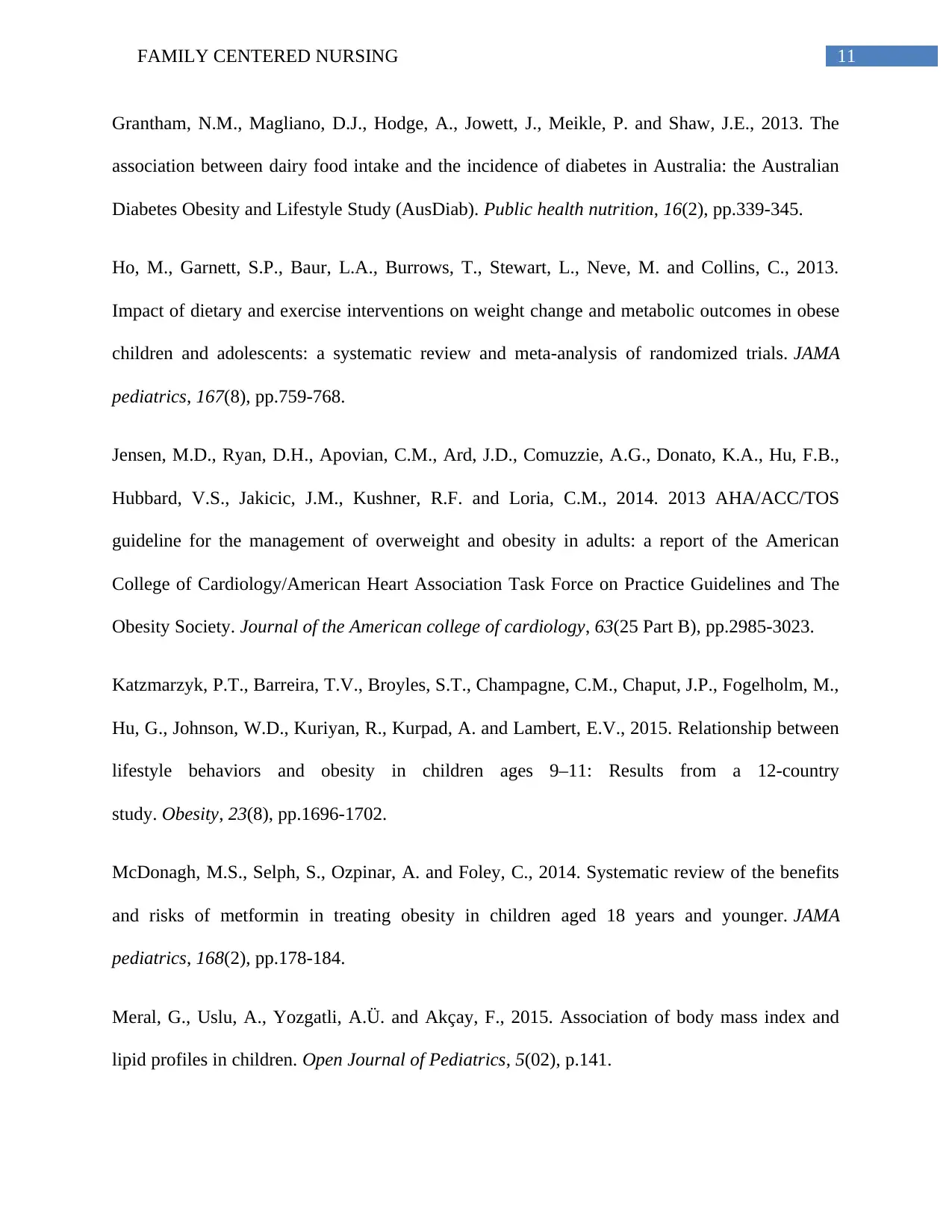
11FAMILY CENTERED NURSING
Grantham, N.M., Magliano, D.J., Hodge, A., Jowett, J., Meikle, P. and Shaw, J.E., 2013. The
association between dairy food intake and the incidence of diabetes in Australia: the Australian
Diabetes Obesity and Lifestyle Study (AusDiab). Public health nutrition, 16(2), pp.339-345.
Ho, M., Garnett, S.P., Baur, L.A., Burrows, T., Stewart, L., Neve, M. and Collins, C., 2013.
Impact of dietary and exercise interventions on weight change and metabolic outcomes in obese
children and adolescents: a systematic review and meta-analysis of randomized trials. JAMA
pediatrics, 167(8), pp.759-768.
Jensen, M.D., Ryan, D.H., Apovian, C.M., Ard, J.D., Comuzzie, A.G., Donato, K.A., Hu, F.B.,
Hubbard, V.S., Jakicic, J.M., Kushner, R.F. and Loria, C.M., 2014. 2013 AHA/ACC/TOS
guideline for the management of overweight and obesity in adults: a report of the American
College of Cardiology/American Heart Association Task Force on Practice Guidelines and The
Obesity Society. Journal of the American college of cardiology, 63(25 Part B), pp.2985-3023.
Katzmarzyk, P.T., Barreira, T.V., Broyles, S.T., Champagne, C.M., Chaput, J.P., Fogelholm, M.,
Hu, G., Johnson, W.D., Kuriyan, R., Kurpad, A. and Lambert, E.V., 2015. Relationship between
lifestyle behaviors and obesity in children ages 9–11: Results from a 12‐country
study. Obesity, 23(8), pp.1696-1702.
McDonagh, M.S., Selph, S., Ozpinar, A. and Foley, C., 2014. Systematic review of the benefits
and risks of metformin in treating obesity in children aged 18 years and younger. JAMA
pediatrics, 168(2), pp.178-184.
Meral, G., Uslu, A., Yozgatli, A.Ü. and Akçay, F., 2015. Association of body mass index and
lipid profiles in children. Open Journal of Pediatrics, 5(02), p.141.
Grantham, N.M., Magliano, D.J., Hodge, A., Jowett, J., Meikle, P. and Shaw, J.E., 2013. The
association between dairy food intake and the incidence of diabetes in Australia: the Australian
Diabetes Obesity and Lifestyle Study (AusDiab). Public health nutrition, 16(2), pp.339-345.
Ho, M., Garnett, S.P., Baur, L.A., Burrows, T., Stewart, L., Neve, M. and Collins, C., 2013.
Impact of dietary and exercise interventions on weight change and metabolic outcomes in obese
children and adolescents: a systematic review and meta-analysis of randomized trials. JAMA
pediatrics, 167(8), pp.759-768.
Jensen, M.D., Ryan, D.H., Apovian, C.M., Ard, J.D., Comuzzie, A.G., Donato, K.A., Hu, F.B.,
Hubbard, V.S., Jakicic, J.M., Kushner, R.F. and Loria, C.M., 2014. 2013 AHA/ACC/TOS
guideline for the management of overweight and obesity in adults: a report of the American
College of Cardiology/American Heart Association Task Force on Practice Guidelines and The
Obesity Society. Journal of the American college of cardiology, 63(25 Part B), pp.2985-3023.
Katzmarzyk, P.T., Barreira, T.V., Broyles, S.T., Champagne, C.M., Chaput, J.P., Fogelholm, M.,
Hu, G., Johnson, W.D., Kuriyan, R., Kurpad, A. and Lambert, E.V., 2015. Relationship between
lifestyle behaviors and obesity in children ages 9–11: Results from a 12‐country
study. Obesity, 23(8), pp.1696-1702.
McDonagh, M.S., Selph, S., Ozpinar, A. and Foley, C., 2014. Systematic review of the benefits
and risks of metformin in treating obesity in children aged 18 years and younger. JAMA
pediatrics, 168(2), pp.178-184.
Meral, G., Uslu, A., Yozgatli, A.Ü. and Akçay, F., 2015. Association of body mass index and
lipid profiles in children. Open Journal of Pediatrics, 5(02), p.141.
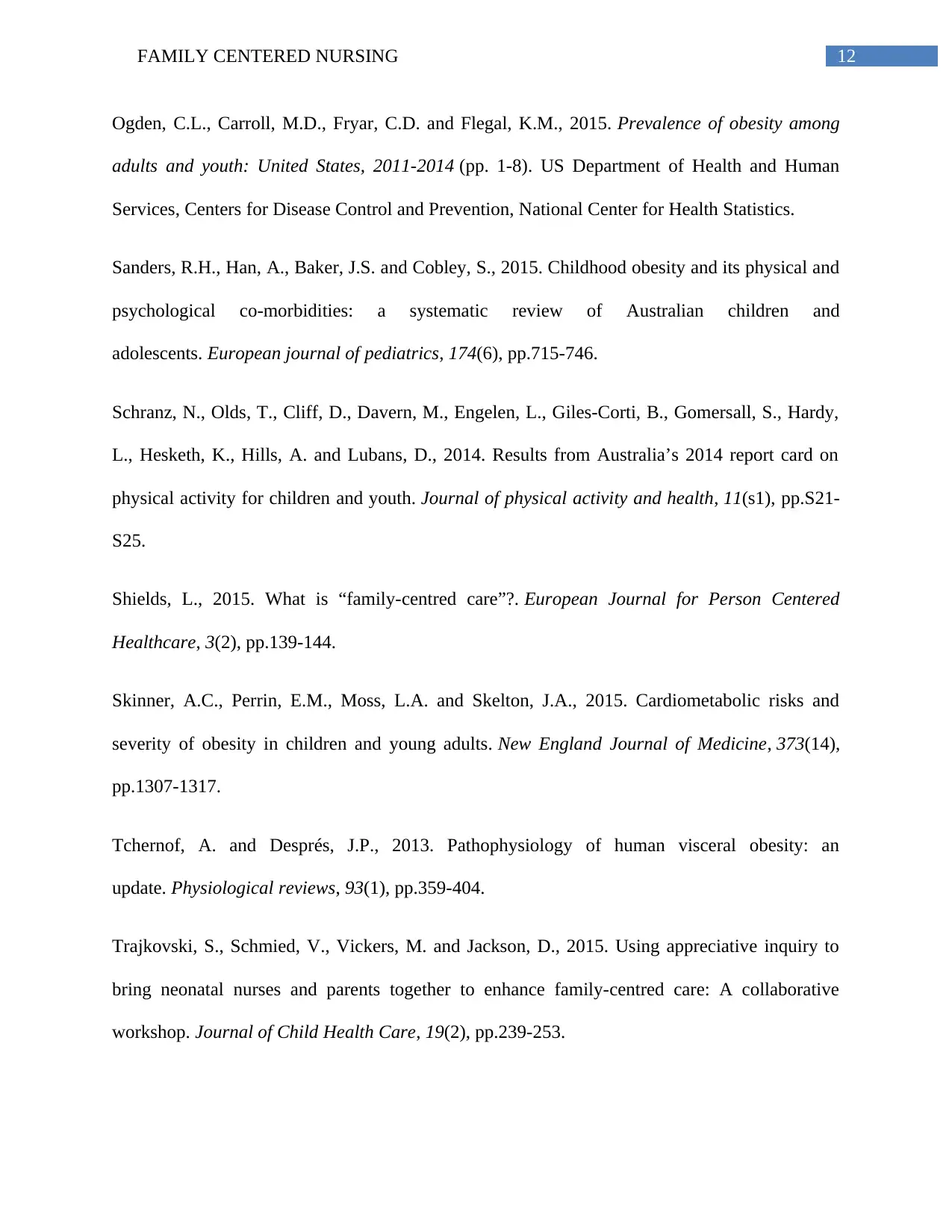
12FAMILY CENTERED NURSING
Ogden, C.L., Carroll, M.D., Fryar, C.D. and Flegal, K.M., 2015. Prevalence of obesity among
adults and youth: United States, 2011-2014 (pp. 1-8). US Department of Health and Human
Services, Centers for Disease Control and Prevention, National Center for Health Statistics.
Sanders, R.H., Han, A., Baker, J.S. and Cobley, S., 2015. Childhood obesity and its physical and
psychological co-morbidities: a systematic review of Australian children and
adolescents. European journal of pediatrics, 174(6), pp.715-746.
Schranz, N., Olds, T., Cliff, D., Davern, M., Engelen, L., Giles-Corti, B., Gomersall, S., Hardy,
L., Hesketh, K., Hills, A. and Lubans, D., 2014. Results from Australia’s 2014 report card on
physical activity for children and youth. Journal of physical activity and health, 11(s1), pp.S21-
S25.
Shields, L., 2015. What is “family-centred care”?. European Journal for Person Centered
Healthcare, 3(2), pp.139-144.
Skinner, A.C., Perrin, E.M., Moss, L.A. and Skelton, J.A., 2015. Cardiometabolic risks and
severity of obesity in children and young adults. New England Journal of Medicine, 373(14),
pp.1307-1317.
Tchernof, A. and Després, J.P., 2013. Pathophysiology of human visceral obesity: an
update. Physiological reviews, 93(1), pp.359-404.
Trajkovski, S., Schmied, V., Vickers, M. and Jackson, D., 2015. Using appreciative inquiry to
bring neonatal nurses and parents together to enhance family-centred care: A collaborative
workshop. Journal of Child Health Care, 19(2), pp.239-253.
Ogden, C.L., Carroll, M.D., Fryar, C.D. and Flegal, K.M., 2015. Prevalence of obesity among
adults and youth: United States, 2011-2014 (pp. 1-8). US Department of Health and Human
Services, Centers for Disease Control and Prevention, National Center for Health Statistics.
Sanders, R.H., Han, A., Baker, J.S. and Cobley, S., 2015. Childhood obesity and its physical and
psychological co-morbidities: a systematic review of Australian children and
adolescents. European journal of pediatrics, 174(6), pp.715-746.
Schranz, N., Olds, T., Cliff, D., Davern, M., Engelen, L., Giles-Corti, B., Gomersall, S., Hardy,
L., Hesketh, K., Hills, A. and Lubans, D., 2014. Results from Australia’s 2014 report card on
physical activity for children and youth. Journal of physical activity and health, 11(s1), pp.S21-
S25.
Shields, L., 2015. What is “family-centred care”?. European Journal for Person Centered
Healthcare, 3(2), pp.139-144.
Skinner, A.C., Perrin, E.M., Moss, L.A. and Skelton, J.A., 2015. Cardiometabolic risks and
severity of obesity in children and young adults. New England Journal of Medicine, 373(14),
pp.1307-1317.
Tchernof, A. and Després, J.P., 2013. Pathophysiology of human visceral obesity: an
update. Physiological reviews, 93(1), pp.359-404.
Trajkovski, S., Schmied, V., Vickers, M. and Jackson, D., 2015. Using appreciative inquiry to
bring neonatal nurses and parents together to enhance family-centred care: A collaborative
workshop. Journal of Child Health Care, 19(2), pp.239-253.
Paraphrase This Document
Need a fresh take? Get an instant paraphrase of this document with our AI Paraphraser

13FAMILY CENTERED NURSING
Xu, F., Greaney, M.L., Cohen, S.A., Riebe, D. and Greene, G.W., 2018. The Association
between Adolescent’s Weight Perception and Health Behaviors: Analysis of National Health and
Nutrition Examination Survey Data, 2011–2014. Journal of Obesity, 2018.
Xu, F., Greaney, M.L., Cohen, S.A., Riebe, D. and Greene, G.W., 2018. The Association
between Adolescent’s Weight Perception and Health Behaviors: Analysis of National Health and
Nutrition Examination Survey Data, 2011–2014. Journal of Obesity, 2018.
1 out of 14
Related Documents
Your All-in-One AI-Powered Toolkit for Academic Success.
+13062052269
info@desklib.com
Available 24*7 on WhatsApp / Email
![[object Object]](/_next/static/media/star-bottom.7253800d.svg)
Unlock your academic potential
© 2024 | Zucol Services PVT LTD | All rights reserved.





